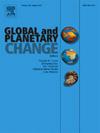Evolutionary history of the Malacca Strait driven by sea level changes over the last 16 ka
IF 4
1区 地球科学
Q1 GEOGRAPHY, PHYSICAL
引用次数: 0
Abstract
The Malacca Strait connects the Sunda Shelf and Andaman Sea, which is a chokepoint for the exchange of both material and energy between two larger bodies of water. However, the evolutionary history of the Malacca Strait is poorly understood, although its development can be closely linked to regional paleoenvironmental changes. In this study, we present multiple new analytical results on the basis of a high-resolution chronology, including grain size, geochemical composition, and Sr![]() Nd isotopic compositions in both labile and detrital fractions of sediments from surface samples as well as core samples. We aim to reveal the evolutionary history of the Malacca Strait by tracing records of the geochemical compositions and Sr
Nd isotopic compositions in both labile and detrital fractions of sediments from surface samples as well as core samples. We aim to reveal the evolutionary history of the Malacca Strait by tracing records of the geochemical compositions and Sr![]() Nd isotopic compositions of both labile and detrital fractions of sediments. A provenance transition between ∼10 and ∼7 ka has been identified, with the occurrence of a Sunda Shelf sediment signal at approximately 10 ka. Combining the shifting provenance and varying depositional environment since 16.28 ka allows us to distinguish three distinct evolutionary stages of the Malacca Strait: 1) Stage I, during 10–15 ka, a general estuary and embayment environment with provenances from the Malaysian Peninsula, Sumatra and the eastern shelf of the Andaman Sea; 2) Stage II, during the early Holocene at 10–7 ka, a period of an initial strait configuration with a narrow and shallow channel, which only allowed restricted sediment and water mass influx into the strait; and 3) Stage III, a highstand of sea level since ∼7 ka, a phase of a fully opened strait with a high-energy hydrodynamic environment dominated by tidal and northwestward currents. It suggested that the initial opening of the strait may have been incapable of providing higher-energy depositional environments, such as those present today, whereas the optimal sea level since 7.26 ka promoted throughflow in the Malacca Strait. Our results demonstrate that sea level was the first-order control of sedimentary evolution in the strait, whereas the monsoon climate only played a secondary role.
Nd isotopic compositions of both labile and detrital fractions of sediments. A provenance transition between ∼10 and ∼7 ka has been identified, with the occurrence of a Sunda Shelf sediment signal at approximately 10 ka. Combining the shifting provenance and varying depositional environment since 16.28 ka allows us to distinguish three distinct evolutionary stages of the Malacca Strait: 1) Stage I, during 10–15 ka, a general estuary and embayment environment with provenances from the Malaysian Peninsula, Sumatra and the eastern shelf of the Andaman Sea; 2) Stage II, during the early Holocene at 10–7 ka, a period of an initial strait configuration with a narrow and shallow channel, which only allowed restricted sediment and water mass influx into the strait; and 3) Stage III, a highstand of sea level since ∼7 ka, a phase of a fully opened strait with a high-energy hydrodynamic environment dominated by tidal and northwestward currents. It suggested that the initial opening of the strait may have been incapable of providing higher-energy depositional environments, such as those present today, whereas the optimal sea level since 7.26 ka promoted throughflow in the Malacca Strait. Our results demonstrate that sea level was the first-order control of sedimentary evolution in the strait, whereas the monsoon climate only played a secondary role.

求助全文
约1分钟内获得全文
求助全文
来源期刊

Global and Planetary Change
地学天文-地球科学综合
CiteScore
7.40
自引率
10.30%
发文量
226
审稿时长
63 days
期刊介绍:
The objective of the journal Global and Planetary Change is to provide a multi-disciplinary overview of the processes taking place in the Earth System and involved in planetary change over time. The journal focuses on records of the past and current state of the earth system, and future scenarios , and their link to global environmental change. Regional or process-oriented studies are welcome if they discuss global implications. Topics include, but are not limited to, changes in the dynamics and composition of the atmosphere, oceans and cryosphere, as well as climate change, sea level variation, observations/modelling of Earth processes from deep to (near-)surface and their coupling, global ecology, biogeography and the resilience/thresholds in ecosystems.
Key criteria for the consideration of manuscripts are (a) the relevance for the global scientific community and/or (b) the wider implications for global scale problems, preferably combined with (c) having a significance beyond a single discipline. A clear focus on key processes associated with planetary scale change is strongly encouraged.
Manuscripts can be submitted as either research contributions or as a review article. Every effort should be made towards the presentation of research outcomes in an understandable way for a broad readership.
 求助内容:
求助内容: 应助结果提醒方式:
应助结果提醒方式:


